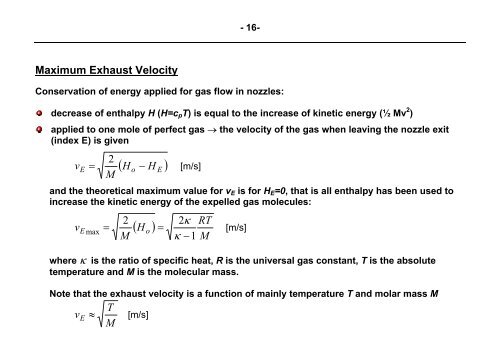S.1 Spacecraft Propulsion Systems Chapter 1: Introduction to ...
S.1 Spacecraft Propulsion Systems Chapter 1: Introduction to ...
S.1 Spacecraft Propulsion Systems Chapter 1: Introduction to ...
Create successful ePaper yourself
Turn your PDF publications into a flip-book with our unique Google optimized e-Paper software.
Maximum Exhaust Velocity<br />
- 16-<br />
Conservation of energy applied for gas flow in nozzles:<br />
decrease of enthalpy H (H=cpT) is equal <strong>to</strong> the increase of kinetic energy (½ Mv 2 )<br />
applied <strong>to</strong> one mole of perfect gas → the velocity of the gas when leaving the nozzle exit<br />
(index E) is given<br />
2<br />
vE = o −<br />
M<br />
( H H )<br />
E<br />
[m/s]<br />
and the theoretical maximum value for vE is for HE=0, that is all enthalpy has been used <strong>to</strong><br />
increase the kinetic energy of the expelled gas molecules:<br />
2<br />
M<br />
( H )<br />
vE max = o<br />
=<br />
2κ<br />
κ −1<br />
RT<br />
M<br />
[m/s]<br />
where κ is the ratio of specific heat, R is the universal gas constant, T is the absolute<br />
temperature and M is the molecular mass.<br />
Note that the exhaust velocity is a function of mainly temperature T and molar mass M<br />
T<br />
vE ≈ [m/s]<br />
M


